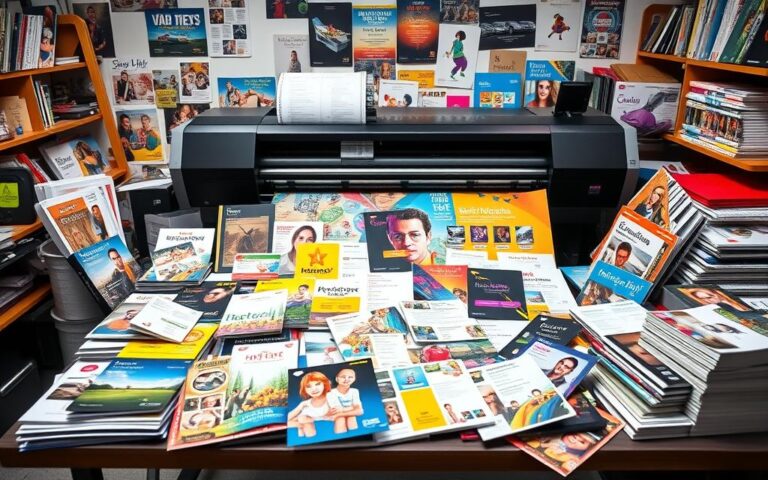Best Practices for Direct Mail Layouts
Did you know that direct mail has a higher response rate than email marketing? In fact, according to the Data & Marketing Association, the response rate for direct mail is 4.9%, compared to just 1% for email marketing. This surprising statistic demonstrates the effectiveness of direct mail as a marketing channel, making it essential for businesses to implement effective direct mail designs to capture attention and drive results.
Key Takeaways:
- Direct mail has a higher response rate of 4.9% compared to email marketing’s 1%.
- Effective direct mail designs are crucial for capturing attention and driving results.
- Implementing best practices in direct mail layouts can help optimize response rates.
- Key factors include clear messaging, strong headlines, eye-catching visuals, readable typography, and compelling calls-to-action.
- Personalization and testing are essential for maximizing the impact of direct mail campaigns.
Understanding Direct Mail: A Unique Marketing Channel
Direct mail marketing strategies and direct mail campaign tips can offer marketers a powerful and tangible way to engage consumers. Unlike digital channels, direct mail stands out by tapping into the sensory nature of consumer engagement. The physical qualities of direct mail create a direct connection that is hard to replicate in the digital world.
Direct mail offers marketers and designers unique opportunities for creativity and flexibility in their layouts. Unlike digital efforts, direct mail provides a tangible canvas to showcase brands, products, and services. This physicality allows for room, flexibility, and layout options that can’t be achieved digitally, making it a versatile marketing channel for compelling storytelling.
“Direct mail offers a unique opportunity for marketers to connect with their audience on a deeper level. Its physical presence and ability to engage multiple senses create an immersive experience that digital channels simply can’t replicate.”
The Power of Storytelling
Story structures have long been proven to be effective in capturing attention and conveying messages. In the realm of direct mail, this is no different. Direct mail campaigns can harness the power of storytelling, especially when targeting an acquisition audience who may be unaware of a brand. By using narratives, character development, and emotional appeals, direct mail can elicit a response and engage recipients in a unique way.
To create impactful direct mail campaigns, marketers should consider implementing direct mail marketing strategies and direct mail campaign tips that not only capture attention but also generate desired responses. Understanding the physicality and storytelling potential of direct mail can help marketers leverage this unique marketing channel effectively.
Direct Mail Design Best Practices
When it comes to designing direct mail campaigns, following best practices is essential to ensure their success. By implementing these direct mail layout principles and graphic design strategies, you can create impactful and engaging mailers that capture the attention of your recipients and drive them to take action.
1. Keep the Message Clear and Concise
Direct mail pieces should convey their message quickly and effectively. Use simple language and avoid cluttering the design with excessive text. Focus on delivering a clear and concise message that resonates with your audience.
2. Use a Strong Headline to Grab Attention
Make sure to include a compelling headline that immediately grabs the reader’s attention. The headline should clearly convey the main benefit or offer of your direct mail and entice recipients to read further.
3. Incorporate Eye-Catching Visuals
Visuals are a powerful tool in direct mail design. Use high-quality images or graphics that support your message and create an emotional connection with your audience. Visuals should be relevant, attention-grabbing, and consistent with your brand identity.
4. Use Readable Typography
Choose fonts that are easy to read and align with your brand’s style. Opt for a legible font size and avoid using too many different fonts in a single mailer. Clear typography helps guide readers through the content and ensures a seamless reading experience.
5. Utilize White Space
White space, or negative space, is the empty space between design elements. It provides visual breathing room, enhances legibility, and improves overall aesthetics. Use white space strategically to highlight important elements and create a balanced composition.
6. Include a Clear Call-to-Action
A strong call-to-action (CTA) is crucial for driving the desired response from your recipients. Clearly state what action you want them to take, such as visiting a website, making a purchase, or contacting your business. Make the CTA prominent and easy to understand.
7. Ensure the Offer is Easy to Read and Understand
If your direct mail includes an offer, make sure it is clearly presented and easy to understand. Highlight the key details, such as discounts, incentives, or limited-time promotions. Use formatting techniques like bold text or bullet points to draw attention to the offer.
8. Test and Measure Different Design Elements
Continuous testing and measuring of different design elements is crucial for optimizing your direct mail campaigns. Experiment with variations of headlines, visuals, layouts, and CTAs to identify which combinations yield the best response rates. Analyze the results and use the insights to refine future campaigns.
9. Design Both the Front and Backside of the Mailer
Make use of the backside of your mailer to complement and reinforce the information on the front. This provides an opportunity to showcase additional visuals, present more detailed content, or include a secondary CTA. Maximize the space available to deliver a comprehensive and compelling message.
By implementing these direct mail best practices, you can create well-designed, attention-grabbing, and effective mailers that drive results for your business.
Interactive Elements in Direct Mail Design
When it comes to direct mail design, incorporating interactive elements can significantly enhance engagement and increase response rates. By incorporating creative direct mail ideas, you can capture the recipient’s attention and encourage them to take the desired action.
Here are some effective interactive elements that you can incorporate into your direct mail campaigns:
- Scratch-off areas: Entice recipients with the element of surprise by including scratch-off areas that reveal special offers or discounts.
- Pop-ups or fold-outs: Make your direct mail piece more memorable by including interactive pop-ups or fold-outs that create a sense of intrigue and excitement.
- Tear-off coupons or perforated elements: Add value to your direct mail by including tear-off coupons or perforated elements that recipients can redeem or share with others.
- Interactive QR codes: Bridge the gap between print and digital mediums by including interactive QR codes that lead recipients to exclusive online content or special promotions.
- Personalized URLs (PURLs): Create a personalized experience by including unique website addresses that direct recipients to landing pages tailored to their interests or demographics.
By incorporating these interactive elements, you can create a direct mail design that goes beyond the conventional and encourages recipients to engage with your brand. Remember to align these creative direct mail ideas with your overall direct mail marketing strategies and direct mail graphic design to ensure a cohesive and impactful campaign.
Tips for Creating an Effective Direct Mail Design
Designing an effective direct mail campaign requires careful consideration and attention to detail. To ensure your direct mail piece captures the attention of your audience and delivers a compelling message, follow these tips:
- Know Your Audience: Understanding your target audience is key to designing a direct mail piece that resonates with them. Consider their demographics, interests, and preferences to tailor both the message and design to their needs and preferences.
- Choose the Perfect Size and Format: The size and format of your direct mail piece can have a significant impact on its success. Consider the information you need to include, the occasion, your target audience, and your budget when selecting the size and format that best suits your campaign’s goals.
- Decide on the Color Scheme Wisely: The colors you choose for your direct mail design can evoke specific emotions and affect how your audience perceives your brand. Stick to your brand standards and use a color scheme that complements your message and captures attention.
- Keep the Copy Concise: Direct mail pieces should be concise and to the point. Use headings, subheadings, and short sentences to convey your message effectively. Include essential elements such as an offer, call-to-action (CTA), and contact information.
- Personalize Your Direct Mail Pieces: Personalization is a powerful tool for increasing engagement and response rates. Utilize variable data printing (VDP) to tailor the content and design of your direct mail pieces to each individual recipient, making your message more relevant and meaningful.
- Make Use of White Space: White space, or empty space, plays a crucial role in directing attention and providing visual clarity. Use white space strategically to highlight key elements, create balance, and improve readability.
- Incorporate Images That Resonate: Images can evoke emotions and help tell your brand’s story. Choose high-quality, relevant images that align with your message and resonate with your target audience. Ensure the images support and enhance the overall design of your direct mail piece.
By following these direct mail campaign tips and best practices, you can create a compelling and effective direct mail design that captures attention, engages your audience, and drives the desired response.
Know Your Audience
In order to create a successful direct mail piece, it is essential to have a deep understanding of your target audience. By knowing their demographics, interests, and preferences, you can design a direct mail piece that truly resonates with them and increases the likelihood of a response.
Tailor the message: When crafting your direct mail content, make sure it aligns with the interests and needs of your intended audience. Take into consideration their pain points and desires, and address them directly in your messaging. By speaking their language and addressing their specific needs, you are more likely to capture their attention and motivate them to take action.
Customize the offers: When designing your direct mail campaign, personalize the offers based on your audience’s preferences. By offering discounts, promotions, or exclusive benefits that are highly relevant to their interests, you create a sense of exclusivity and value that can entice them to respond.

- Create a more personalized experience
- Incorporate images that resonate with your target audience
- Use language and tone that matches their preferences
- Consider their stage in the customer journey and design the direct mail to align with their needs
- Include testimonials or case studies from customers who are similar to your target audience, to build trust and credibility
By knowing your audience inside out and tailoring your message, offers, and images accordingly, you can create a direct mail piece that truly speaks to them. This personalized approach increases the chances of engagement, response, and ultimately, the success of your direct mail campaign.
Choose the Perfect Size and Format
When designing a direct mail piece, it’s crucial to consider the size and format that will best suit your needs. The size and format you choose will depend on factors such as the amount of information you need to include, the occasion or purpose of the mail piece, your target audience, and your budget constraints. By selecting the right size and format, you can enhance the effectiveness of your direct mail campaign and achieve your desired outcomes.
Postcards, letters, and brochures are among the common formats used for direct mail. Postcards are ideal for short and impactful messages, as their compact size allows for easy scanning and quick understanding of the main message. Letters provide more space for detailed explanations, storytelling, and personalization. Brochures offer a combination of engaging visuals and informative content, making them suitable for showcasing products or services in a visually appealing way.
Consider the impact that the size of your direct mail piece will have on grabbing attention. A larger size may stand out more and catch the recipient’s eye, while a smaller size may feel more intimate and personal. Additionally, the format you choose should align with your messaging needs and budget. A well-designed and properly sized direct mail piece can make a significant impact on the success of your campaign.
Incorporate eye-catching visuals and compelling copy
An effective direct mail design should include eye-catching visuals that align with your brand and message. Images, graphics, and illustrations can help convey the main idea and capture the recipient’s attention. Additionally, incorporating compelling copy with a strong headline can pique curiosity and encourage further engagement.
Direct mail offers a unique opportunity to showcase your brand story and create a memorable experience. By choosing the right size and format, you can maximize the impact of your message and increase the likelihood of a response from your target audience.
In conclusion, selecting the perfect size and format for your direct mail piece is essential for effective direct mail design. Consider the information you need to convey, the target audience, and the budget constraints. By following direct mail layout principles and incorporating effective design elements, such as eye-catching visuals and compelling copy, you can create a direct mail piece that stands out and captures attention.
For more information on direct mail design best practices, refer to the Campaign Monitor Guide.
Decide on the Color Scheme Wisely
When designing your direct mail pieces, choosing the right color scheme is crucial to capturing your audience’s attention and making a lasting impression. A well-chosen color palette can create an inviting and aesthetically pleasing design that stands out from other mail pieces.
Start by selecting two or three main colors that align with your brand and evoke the desired emotions in your audience. Using these colors consistently throughout your content will help maintain visual uniformity and reinforce your brand identity.
Consider the Psychology of Colors
Colors have the power to influence and evoke specific feelings and emotions. Understanding the psychology of colors can help you make informed decisions when selecting your color scheme.
For example, warm colors like red and orange are often associated with energy, passion, and excitement, making them suitable for promoting special offers or limited-time deals in your direct mail pieces.
Cool colors like blue and green, on the other hand, tend to be associated with calmness, trust, and reliability. These colors can be effective in building a sense of trust and credibility in your brand.
Neutral colors like gray can help create a sense of balance and sophistication, while bold and vibrant colors can add a sense of excitement and playfulness to your design.
Consider your target audience and the emotions you want to evoke when choosing colors for your direct mail design.
Ensure Visual Hierarchy and Readability
When incorporating colors into your direct mail design, it’s important to maintain visual hierarchy and readability. Use contrasting colors for your text and background to ensure legibility and make your message easily understandable.
Remember to keep the overall design balanced and avoid overwhelming your recipients with too many colors. A well-executed color scheme will enhance the visual appeal of your direct mail and make it more engaging for your audience.
Experiment with different color combinations and seek feedback from others to ensure your color scheme effectively communicates your brand identity and resonates with your target audience.
Craft Creative Mail with Your Brand’s Colors
When it comes to direct mail design, incorporating your brand’s colors is essential for creating a memorable and impactful piece. By using your brand’s colors strategically throughout your direct mail design, you can reinforce your brand identity and establish a strong association between your brand and the mail piece.
Using your brand’s colors in direct mail design enhances recognition and recall among recipients. When recipients see familiar colors associated with your brand, it triggers a sense of familiarity, making your mail piece more memorable and increasing the chances of a response.
Incorporating your brand’s colors strategically can be done in various ways. For example, you can use your brand’s primary color as the dominant color in your mail piece, ensuring it is prominently featured. Alternatively, you can use your brand’s colors as accents or highlights, creating visual interest and tying your direct mail design to your brand identity.
Remember to use your brand’s colors consistently throughout the design. Consistency helps create a cohesive and harmonious look, reinforcing your brand identity and making a lasting impression on recipients.
When crafting your direct mail design, consider the psychology of color and how different hues can elicit certain emotions or associations. Choose colors that align with your brand’s personality and values, and that resonate with your target audience.
By incorporating your brand’s colors creatively, you can elevate the visual impact of your direct mail and make it more engaging for recipients. Whether it’s through color choice, color placement, or color combinations, leveraging your brand’s colors effectively can help you create a direct mail piece that stands out and leaves a lasting impression on your audience.
Keep Your Copy Concise
When it comes to direct mail campaigns, concise copy is key to grabbing and maintaining the reader’s attention. By using a clear and straightforward language, you can effectively convey your message and encourage the desired response from your audience. Here are some best practices to follow:
Use Headings and Subheadings
Break up your copy into sections with headings and subheadings. This not only helps organize your content but also allows readers to skim through the mailer and quickly grasp the main points. Use keywords and phrases that align with your message to optimize your direct mail for search engines.
Employ Short Sentences
Avoid lengthy and complex sentences that may confuse or lose your readers. Instead, opt for short, concise sentences that are easy to read and understand. This ensures that your message is delivered clearly and effectively.
Highlight Key Elements
Including key elements such as an offer, call-to-action (CTA), and contact information is essential in every direct mail piece. Make sure these elements stand out by using formatting techniques like bolding or italicizing. This helps draw attention to the most important parts of your mailer.
Limit Content for Letters
For direct mail letters, it’s crucial to keep the content to one page. Long letters may overwhelm readers and decrease engagement. By limiting the content, you can maintain reader interest and increase the chances of your message being read and acted upon.
Remember, direct mail is a powerful marketing tool, but its effectiveness relies on delivering a clear and concise message. By following these direct mail campaign tips, you can ensure that your copy is compelling, engaging, and drives the desired response from your target audience.
Personalize Your Direct Mail Pieces
One of the key direct mail best practices is to personalize your direct mail campaigns using variable data printing (VDP). By tailoring the message and design to each individual recipient, you can create a more meaningful and relevant experience. This personalization increases the likelihood of a response and improves the overall effectiveness of your direct mail campaign.
Using VDP, you have the ability to modify the content or images of your direct mail based on the recipient’s interests and data. This level of customization allows you to make a deeper connection with your audience. Whether it’s addressing them by name, referencing their previous purchases or interactions, or offering tailored recommendations, personalized direct mail demonstrates that you value their individual needs and preferences.
Personalization goes beyond just variable data. You can also incorporate personalized URLs (PURLs) that direct recipients to a landing page with their specific information already prepopulated. This seamless transition from the printed mailer to the digital realm enhances the user experience and encourages further engagement.
Studies have shown that personalized direct mail generates higher response rates and ROI compared to generic mass mailings. According to a study conducted by Ironmark, a marketing and print services provider, personalization resulted in a 44% increase in response rates.
“Personalization is no longer just a nice-to-have in direct mail. It has become an expectation for consumers. By leveraging the power of variable data printing, marketers can create more relevant and engaging direct mail pieces that stand out in the mailbox and drive action.” – Ironmark
Incorporating personalization into your direct mail pieces requires access to accurate data, a robust customer database, and a strategic approach to implementing VDP. By investing the time and resources into personalization, you can create a direct mail campaign that speaks directly to your audience, increasing the chances of conversions and building long-term customer relationships.
Conclusion
Designing direct mail layouts is an art that requires careful consideration of various factors. By following best practices and incorporating effective strategies, you can create impactful direct mail campaigns that capture attention and drive results.
One crucial aspect is understanding your audience and tailoring the message and design to their preferences. By knowing their demographics, interests, and preferences, you can create personalized direct mail pieces that resonate with your target market.
Additionally, choosing the perfect size and format, selecting a suitable color scheme, and keeping the copy concise are key elements of effective direct mail design. Personalization and utilizing white space can also enhance the overall impact of your mailers.
Finally, it’s essential to measure and test different design elements to optimize your future campaigns. Constantly assessing and refining your direct mail layouts will help you deliver better results and improve your overall direct mail marketing strategies.
For more insights on how direct mail has become more dynamic, check out this article.
FAQ
What are the best practices for direct mail layouts?
The best practices for direct mail layouts include having a clear and concise message, using a strong headline, incorporating eye-catching visuals, using readable typography, utilizing white space effectively, including a clear call-to-action (CTA), and testing and measuring different design elements.
Why is direct mail considered a unique marketing channel?
Direct mail stands out from other marketing efforts due to its physicality, creating a direct connection that taps into the sensory nature of consumer engagement. Additionally, direct mail offers the flexibility and layout options that can’t be achieved with digital channels, making it ideal for compelling storytelling.
What are some best practices for direct mail design?
Some best practices for direct mail design include keeping the message clear and concise, using a strong headline, incorporating eye-catching visuals, using readable typography, utilizing white space effectively, including a clear call-to-action, ensuring the offer is easy to read and understand, testing and measuring different design elements, and designing both the front and backside of the mailer to complement each other.
How can interactive elements enhance direct mail design?
Interactive elements, such as scratch-off areas, pop-ups or fold-outs, tear-off coupons or perforated elements, interactive QR codes, and personalized URLs (PURLs), can boost engagement and responses in direct mail design. These elements enhance the overall user experience and bridge the gap between print and digital mediums.
What are some tips for creating an effective direct mail design?
Some tips for creating an effective direct mail design include knowing your audience and tailoring the message and design to their preferences, choosing the perfect size and format, deciding on a suitable color scheme, keeping the copy concise, personalizing the direct mail pieces, making use of white space, and incorporating images that resonate with the audience.
Why is it important to know your target audience for direct mail?
Understanding your target audience is crucial for crafting a successful direct mail piece. By knowing their demographics, interests, and preferences, you can design a direct mail piece that resonates with them and increases the likelihood of a response. Tailoring the message, offers, and images to the intended demographic creates a more personalized experience.
How should I choose the size and format for my direct mail piece?
The size and format of your direct mail piece should be chosen based on the information you need to include, the occasion, your target audience, and your budget. Postcards, letters, and brochures are common formats used for direct mail. Consider the effect of the size on the attention it will receive and choose a format that best suits your messaging needs and budget constraints.
What should I consider when selecting a color scheme for my direct mail design?
The colors you choose for your direct mail design should be inviting, create a pleasant aesthetic, and stand out from other mail pieces. Stick to two or three main colors and use them consistently throughout the content to maintain uniformity. Consider the emotions associated with different colors and choose hues that evoke the desired feelings in your audience.
How can I incorporate my brand’s colors into my direct mail design?
Using your brand’s colors in your direct mail design increases recognition and recall among recipients. It helps create a strong association between your brand and the mail piece, making it more memorable. Incorporate your brand’s colors strategically in the design to reinforce your brand identity and make a lasting impression.
How should I keep the copy in my direct mail concise?
To keep the copy in your direct mail concise, use headings, subheadings, and short sentences to convey your message effectively. Include key elements such as an offer, call-to-action (CTA), and contact information. For letters specifically, limit the content to one page to maintain reader engagement.
How can I personalize my direct mail pieces?
Personalizing your direct mail pieces using variable data printing (VDP) allows you to tailor the message and design to each individual recipient. By modifying content or images based on the recipient’s interests and data, you can create a more meaningful and relevant experience. Personalization increases the likelihood of a response and improves the overall effectiveness of the direct mail campaign.
What are the key takeaways for designing effective direct mail layouts?
Designing direct mail layouts requires following best practices to capture attention, communicate the message effectively, and encourage a response. By incorporating these tips, such as knowing your audience, choosing the perfect size and format, selecting a suitable color scheme, keeping the copy concise, personalizing the direct mail pieces, utilizing white space, and sticking to your brand standards, you can create impactful and successful direct mail campaigns. Remember to test and measure different design elements to optimize future campaigns and deliver better results.







